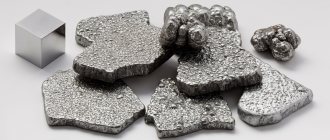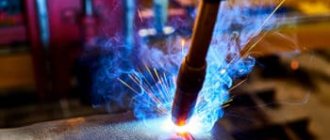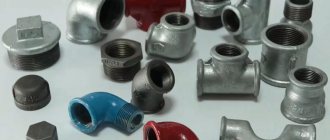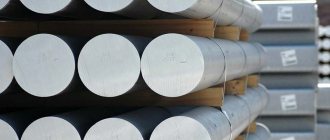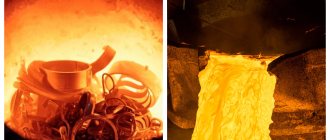In industry and everyday life, cast iron products are widely used. The metal is iron, which has 2 percent carbon integrated into its molecular structure. Today, many grades of metal are produced that have different fracture characteristics. About a hundred species.
Production requires a huge amount of thermal energy, since the melting point of cast iron is over one thousand degrees Celsius. Melting occurs at a temperature of 1150 - 1200 C°.
In addition to carbon, to obtain the required grade, silicon, sulfur, manganese, and phosphorus are added to the batches. Increased strength is achieved by incorporating alloying additives into the batches.
Types of cast iron
There are several types of cast iron. Various alloying impurities are added to it, which change the characteristics of the solid material. For this, aluminum, chromium, vanadium or nickel are used. In addition to them there are other impurities. The parameters of finished products directly depend on the composition of the alloy. Varieties:
- Gray cast iron. It is considered the most popular type. The composition contains 2.5% carbon, which is a particle of graphite or perlite. Has a high strength index. Gray cast iron is used to make parts that can withstand constant loads. These can be gears, housing parts, bushings.
- White cast iron. The carbon contained in the composition is carbide particles. A white mark remains on the fracture of the material, which corresponds to the name. Carbon content averages more than 3%. A fragile and brittle type of material, which is why it is used only in static parts.
- Half-hearted. Combines the characteristics of the two previous types of cast iron. Graphite and carbide particles saturate the metal with carbon. Its content is from 3.5 to 4.2%. Wear-resistant material used in mechanical engineering. Withstands constant friction.
- Malleable cast iron. It is obtained from the second type of material, after annealing. The alloy contains carbon in the form of ferrite particles. Its amount is about 3.5%. Like half-shaft, it is used for the manufacture of parts in mechanical engineering.
To obtain a high-strength material, graphite particles are processed so that they take on a spherical shape and fill the crystal lattice. Magnesium, calcium or cerium are added to the alloy.
Grid changes
With increasing heat (cast iron melts at a temperature of 1200 degrees Celsius), the crystal lattice transitions into the current liquid state. It is at this moment that the internal energy of the metal increases. Having reached heating above one thousand degrees, the crystal lattice is destroyed. At this time, incoming thermal energy continues to weaken molecular bonds. There is an increase in energy reserves inside the metal. It is several times higher than that containing crystallized material.
The cessation of heating is the beginning of cooling of the metal. A reverse crystallization process occurs, developing according to a dendritic algorithm. That is, from the points that motivate such development. They (dendrites) act as a priori stages of the process. The crystal grows, as it were, from the center of the phenomenon. In liquid, but already cooling cast iron, crystallization occurs according to the principle of the structure of wood. The process involves dendrites of cementite, austenite and graphite. It has been established thermodynamically that it is spherical graphite that is represented by a dendrite having a sectoral layered structure.
Thermal properties of cast iron
The characteristics of a metal depend on its thermal properties. They change when treated with high and low temperatures. Directly depend on the composition of the alloy.
Heat capacity
Heat capacity is the processing of metal with heat. Heats up until the temperature of the workpiece rises by one Kelvin. This indicator depends on the presence of additional components in the alloy and temperature. If it is high, then the heat capacity will be greater. Average heat capacity:
- Hard metal - 1 cal/cm3G.
- Molten material - 1.5 cal/cm3G.
From these indicators the ratio of heat capacity and volume of the substance is calculated.
Molten metal
Thermal conductivity
This parameter determines how well a material can conduct heat energy. It depends not only on the components in the alloy, but also on the structure of the metal. The thermal conductivity for a solid material is higher than for a molten one. For different grades of steel, this indicator varies within 0.08–0.13 cal/cm sec oC.
Thermal diffusivity
This physical quantity reflects the ability of a material to change body temperature. When calculating, it is necessary to take into account the following indicators:
- Thermal conductivity range for different grades of cast iron. Applicable to solid material.
- For liquid metal - 0.03 cm2/sec.
Additionally, the heat capacity indicator is taken into account.
Mechanical Features
Tensile strength
The compressive strength of cast iron depends on the structure of the material itself. The components of the structure gain their strength along with an increase in the level of dispersion. The tensile strength is strongly influenced by the number, size, distribution and formagraphite inclusions. The tensile strength decreases by a noticeable amount if the graphite inclusions are arranged in the form of a chain. This arrangement reduces the cohesion of the metal mass.
The tensile strength reaches its maximum value when the graphite takes on a spheroidal shape. This form is obtained without the influence of temperature, but when cerium and magnesium are included in the cast iron mass.
- When the melting temperature increases to 400ºС, the tensile strength does not change.
- If the temperature rises above this value, the tensile strength decreases.
- Note that at temperatures from 100 to 200ºС, the tensile strength can decrease by 10-15%.
Plastic
The ductility of cast iron largely depends on the shape of the graphite, and also depends on the structure of the metal mass. If graphite inclusions have a spheroidal shape, then the percentage of elongation can reach 30.
- In ordinary gray cast iron, the elongation reaches only a tenth.
- In annealed gray cast iron, the elongation is 1.5%.
Elasticity
Elasticity depends on the shape of the graphite. If the graphite inclusions did not change, and the temperature increased, then the elasticity remains at the same value.
The elastic modulus is considered a conditional value, since it has a relative value and directly depends on the presence of graphite inclusions. The elastic modulus decreases if the number of graphite inclusions increases. Also, the elastic modulus increases if the shape of the inclusions is distant from the globular shape.
Impact strength
This indicator reflects the dynamic properties of the material. The impact strength of cast iron increases:
- when the shape of graphite inclusions is close to spherical;
- when the ferrite content increases;
- when the graphite content decreases.
Endurance limit
The endurance limit of cast iron becomes greater when the frequency of loading increases and the tensile strength becomes greater.
Melting temperature
Cast iron is considered the best metal for smelting. Its high fluidity rate and low shrinkage allow it to be used more effectively in casting. Below are the boiling points for different types of this metal in degrees Celsius:
- Gray cast iron - melting point reaches 1260 degrees. When pouring into molds it rises to 1400.
- White - melts at 1350 degrees. Poured into molds at 1450.
The melting rates of cast iron are 400 degrees lower than those of steel. This reduces energy costs when processing cast iron.
physical characteristics
Weight
The weight of the material varies depending on the amount of fixed carbon and the presence of a certain percentage of porosity. The specific gravity of cast iron at the melting point can be significantly reduced depending on the presence of impurities in the cast iron.
In addition, the linear expansion of the metal and the structure of cast iron changes depending on the state of each indicator. That is, these are dependent quantities.
The specific gravity of each cast iron differs depending on the type of material. Gray cast iron has a specific gravity of 7.1±0.2 g/cm3, white cast iron has a specific gravity of 7.5±0.2 g/cm3, and malleable cast iron has a specific gravity of 7.3±0.2 g/cm3.
The video below will tell you about some of the physical properties of cast iron:
Volume
The volume of cast iron, passing through the temperature of phase transformations, reaches an increase of 30%. However, when heated to 500ºC, the volume increases by 3%. Growth is aided by graphite-forming elements. Carbide-forming components inhibit volume growth. The same growth is prevented by applying galvanic coatings to the surface.
The carbon content is usually at least 2.14%. Thanks to the carbon content, cast iron has excellent hardness. However, the plasticity and malleability of the material suffers against this background.
We will talk about the density of cast iron below.
Density
The density of the described material, cast iron, is 7.2 g/cm3. If we compare other metals and alloys with cast iron, this density value is quite high.
Due to its good density, cast iron is widely used for casting various parts in industry. In terms of this property, cast iron is only slightly inferior to some steels.
The influence of chemical elements on the properties of metal
To understand how impurities affect the characteristics and properties of cast iron, it is necessary to understand the structure of its individual types:
- White - The form of carbon in this variety is carbide. White color is visible at the break. It is considered a brittle and brittle material that is rarely used in industry without additives.
- Gray cast iron. The graphite plates in this material saturate it with carbon. To use the material in the production of parts for industrial equipment, the shape of the grains is changed by melting.
- Malleable - The graphite grains in this type of metal have the appearance of flakes.
High-strength cast iron is obtained by adding magnesium to the alloy. To improve the characteristics of this metal, impurities are used.
Impurities
Each impurity added to iron and carbon changes the properties of the finished material. The influence of additives on the quality of cast iron:
- Magnesium. Allows you to make spherical grains in the material. This increases the strength and hardness of the workpiece.
- Manganese. Slows down the graphitization process. The metal is whiter at fractures.
- Silicon. Increases graphitization of the material. The maximum amount of silicon in the workpiece is 3.5%. The strength indicator depends on its quantity.
- Sulfur. The amount of this impurity is reduced to improve fluidity.
- Phosphorus. Has virtually no effect on the graphitization process. Improves fluidity. By adding phosphorus to the alloy, wear resistance and strength are improved.
Alloy materials can be added to cast iron.
Sulfur
Differences from steel
Cast iron and steel are often compared, but they differ from each other in many ways, and among the main differences:
- Cast iron alloy has lower hardness and density.
- Different amounts of carbon.
- The need for casting for cast iron, when steel only needs forging or welding.
- Color, since steel products shine, and cast iron ones are always matte black.
- Steel requires hardening.
- Cast iron alloy weighs less than steel.
And another important difference is that the primary product in ferrous metallurgy is called cast iron, and the final product is called steel.
Self-smelting technology
Knowing at what temperature cast iron melts, you can carry out independent smelting. However, this is a costly and time-consuming process. It is impossible to make a high-quality casting without special equipment.
First of all, you need to equip a separate room with good ventilation. The smelting process is carried out in a furnace. The best option is a blast furnace. It can be used to process large volumes of consumables (iron ore). The fuel used is coke. However, this is industrial equipment that requires special conditions of use.
Induction furnaces are used in our own workshops.
The raw materials are melted in crucibles. During the smelting process, it is necessary to use flux, which creates a low-melting slag. Once the metal is molten, the craftsman pours it into sand or metal molds. The melting point of cast iron varies slightly depending on the type of material and the impurities it contains. It is extremely difficult to process this metal at home. It is necessary to equip the room, take care of ventilation and fire safety. After preparation, install the furnace and other equipment for smelting.
Stainless steel
Stainless steel is one of the many iron alloys found in steel. It contains Chromium from 15 to 30%, which makes it rust-resistant, creating a protective layer of oxide on the surface, and carbon. The most popular brands of this type are foreign. These are the 300th and 400th series. They are distinguished by their strength, resistance to adverse conditions and ductility. The 200 series is of lower quality, but cheaper. This is a beneficial factor for the manufacturer. Its composition was first noticed in 1913 by Harry Brearley, who conducted many different experiments on steel.
At the moment, stainless steel is divided into three groups:
- Heat-resistant - at high temperatures it has high mechanical strength and stability. The parts that are made from it are used in the pharmaceutical, rocketry, and textile industries.
- Rust-resistant - has great resistance to rusting processes. It is used in household and medical devices, as well as in mechanical engineering for the manufacture of parts.
- Heat-resistant - resistant to corrosion at high temperatures, suitable for use in chemical plants.
The melting point of stainless steel varies depending on its grade and the number of alloys from approximately 1300 °C to 1400 °C.
